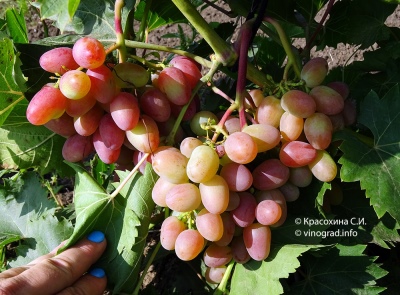
- Authors: Kapelyushny Vasily Ulyanovich
- Appointment: dining room
- Berry color: pink
- Taste: harmonious, nutmeg
- Ripening period: very early
- Ripening period, days: 95-100
- Frost resistance, ° C: -25
- Bunch weight, g: 700-900
- Flower type: functionally female
- Peeling: No
Among the table grape varieties, there are many different types, and the Parisienne grape is considered one of the striking examples. In this article, we will consider the characteristics of the variety, yield, taste of berries, frost resistance, as well as the way of storing bunches.
Breeding history
The Parisian grape is of domestic production, it was created by an amateur breeder V. Kapelyushny. The parental pair of the future hybrid was the varieties Vera and Muromets.
Description
Grape bushes grow very actively throughout the season. In the summer alone, the vine grows by 3 m. On average, the height of one vine reaches 6 m. Therefore, due to the active growth of branches, it is necessary to think over a system of trellises so that the vine does not bend to the ground, but grows upright.
The parisianka cuttings have good rooting, if you follow all the rules of agricultural technology, then all new cuttings will have roots.
The leaves of the bushes have a deep green hue, the back is lighter than the front, there are 5 blades, there is a pronounced central section. The surface of the sheets is rough. The Parisian grape during flowering has a pleasant, but weak aroma.
Ripening period
This hybrid is an early maturing variety. Harvesting begins 90 days after the buds swell. On average, the ripening period reaches 100-110 days in different regions. The harvest can be taken already at the beginning of August.
Bunches
The grapes have large clusters, conical in shape, with medium density. The weight of the hand ranges from 700 to 900 g. However, there are also heavier hands.
Berries
The shape of the berries is ovoid. The skin is pink with a certain green-golden tint, there is shine, thin, during use it is practically not felt. The pulp is juicy, fleshy. The berries weigh 10-14 g. The average size is 3.6 cm in length and 2.8 cm in width.
Taste
The berries have a pleasant, sweet taste, nutmeg notes are felt. The aroma is pronounced.
Yield
The yield of the Parisianka variety is high. An average of 8-10 kg of berries can be removed from one bush, up to 15 kg of berries can be removed from large bushes.


Growing features
Grapes are very fond of light and sandy soil, it must be saturated with a large amount of minerals, as well as organic matter. If the soil is more clayey, then it is better to dig it up several times, mixed with sandy soil, in order to artificially recreate the necessary soil.
Grapes do not like excessive moisture, as the roots suffer from this. Therefore, it is worth planting seedlings in lowlands or swampy places, as well as places where groundwater is present.
The place should be chosen sunny, if planted along the verandas, it is best on the south side.
Landing
In order to grow Parisian grapes, it is necessary to properly prepare the soil.If it is not possible to dig up the site in advance, then it is necessary to dig a hole 0.8-0.9 m deep. For this, pebbles, broken bricks are suitable. Then you need to sprinkle the drainage with earth along with fertilizers, lower the seedling, gradually bury it, tamping the earth. The planted seedlings must be spilled with a bucket of warm water.
The distance between the bushes must be 2 m, and between the rows 3 m.

Pollination
The flowers of the Parisian woman are predominantly female, although many gardeners argue that additional pollination is not necessary, since the ovaries still occur, but the quality of the fruits deteriorates sharply.
Therefore, it is better to plant several grape bushes with male flowers next to Parisian.
Pruning
Grape bushes tend to be overloaded, so to avoid this, pruning must be done every season. On average, 35-45 eyes should remain.
Weak shoots and lower foliage are also removed.
In the fall, pruning is carried out after the last leaves have fallen, after about 2 weeks. Diseased branches, antennae and stepsons are removed, and the vine is shortened by 6-8 buds.



Frost resistance and the need for shelter
This hybrid has a high frost resistance, up to -25 degrees. But nevertheless, sharp changes in temperature adversely affect the bushes, therefore, in the central and northern regions, it is still worth covering them. To do this, you need to remove everything left after pruning the vines, twist them and put them on the board, you should not allow contact with the ground. After that, the vines can be covered with spruce branches, and then with a covering covering.

Diseases and pests
The Parisian grape is resistant to many types of diseases and pests, but it is still worth taking preventive measures to protect the crop. It is necessary to choose those drugs that do not penetrate into the plant, but only fight against pests on the surface. Such preparations will not affect the harvest in any way.

If a grape is exposed to any disease or insect, this always affects its appearance.
Storage
The Parisienne grape has a good shelf life and transportation. For storage, wooden boxes are selected, sawdust is poured on the bottom, bunches are laid out, a layer of sawdust is poured on top, and the second row is laid out. Store in a dark place at a temperature not exceeding +2 degrees Celsius.











































































